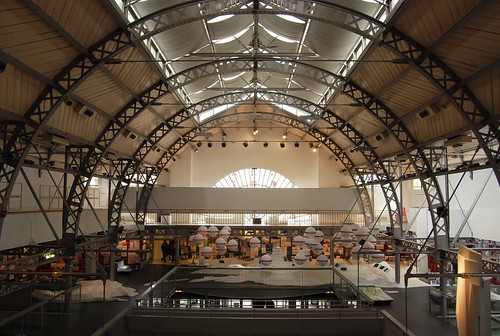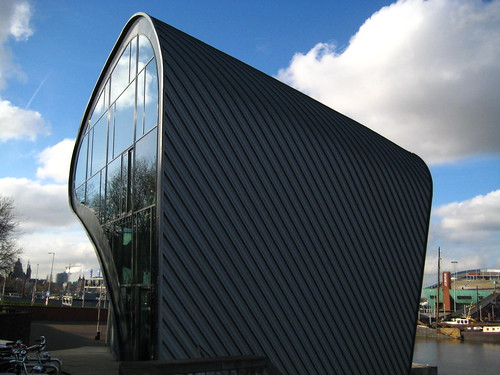
On Saturday in the Toronto Star’s Ideas section I wrote an article proposing an “Urban Centre” be established here in Toronto. “Does Toronto need an Urban Centre?” is the theme of tomorrow night’s Toronto the Good party in the Distillery District. ERA Architects, our co-hosts of the party, are the prime movers behind this idea, and we hope the party will generate excitement around this idea and begin to form a constituency for an Urban Centre in our city. Below is an expanded version of the article, with more examples of Urban Centres in other cities.
Two months ago Ballenford Books closed after 29 years in business as Toronto’s only architectural bookstore. While it is always sad to lose an independent bookstore, Toronto was doubly hit because Ballenford dedicated a portion of its small Mirvish Village retail space to regular, Toronto-focused architectural and photographic exhibitions. Even when not shopping for a particular book, you knew you could pop into the store and see something exciting up on the walls — something that might generate thoughts about city life and city building in Toronto.
With Ballenford gone, the city has lost a small version of an important civic institution that other cities enjoy: an “urban centre.” An urban centre is a place where the city itself is the focus: One day you might see something that makes you angry, the next you might fall a little more in love with the metropolis. It’s a place where you can go to see what’s happening in the city, where you can take the pulse of current developments and participate in public conversations. A resource centre for the general public to get information and find its place in city development, it’s also a place for policy wonks, architects, planners and students who want and need to have deeper discussions about city development.
Apart from the small but dedicated role Ballenford played in Toronto, other institutions serve as small urban centres at times. The Toronto Archives on Spadina Rd. has a large exhibition hall that runs excellent year-long exhibitions where its deep collection is mined, curated, and made public. On the west side, recently moving into their new Bloor and Lansdowne location, the Toronto Free Gallery routinely shows critical, Toronto-based artwork that looks at urban issues. Though devoted to all design fields, the Design Exchange holds urban-themed charettes and events periodically. Even the giant panorama model of central Toronto in the lobby of City Hall is a popular example of how much latent need there is for an urban centre in Toronto. Linger there for a while and you’ll see a steady stream of people looking and pointing at it: It’s one of the few places in Toronto where strangers regularly speak to each other, so powerful is this simple exhibit. Even without any interpretation, the city itself can hold people’s attention.
Some of the world’s great cities have urban centres that have become as important civic and cultural attractions as their traditional museums and landmarks are. The Chicago Architecture Foundation runs more than 7,800 tours of that city each year, including the exceptional riverboat tours of its famous buildings and development history. The foundation grew out of a fear in the 1950s and 1960s that Chicago was losing some of it’s great architectural legacy to the wrecking ball, a sentiment Torontonians are familiar with.
Over 125,000 people a year either take a tour or pass through their exhibition space on Michigan Avenue, and the foundation tours stand out from standard tourist fare because they don’t gloss over the city — you see the bad and the beautiful together. It is, if such a thing exists, intelligent tourism. Similarly, in Washington, D.C. the National Building Museum welcomes over 400,000 visitors a year for exhibitions like “Me, Myself and Infrastructure.” Over in Turin, Italy, the Officina Citta’ Torino will be housed in a renovated historic train station.
Since 1988, visitors and residents of Paris have been able to visit the Pavillon de L’Arsenal, a “centre for information, documentation and exhibition for urban planning.” Founded by the French national government, it provides a space where Parisian architecture and urban planning can be celebrated and critiqued, documentation distributed and where current projects that will affect the day to day life of residents can be looked at and discussed in person. More than 200,000 people visit it each year.
In San Francisco, an ambitious $14 million Urban Centre is under construction, a project of the San Francisco Planning and Urban Research Association (SPUR). SPUR was founded in 1959 to fight for the revitalization of San Francisco and has become an independent urban think tank with over 3000 members. Once open, SPUR’s four storey Urban Centre will be the place to go to in San Francisco for urban resources and will include an urban affairs library and two floors of gallery and reception space.
Gabriel Metcalf, SPUR’s Executive Director, has said the Urban Centre will be “a new tool to really involve the public in understanding and participating in the future of the city through the shared experience that only occurs with the public working side-by-side in a non-adversarial setting.”
For many people, the planning process is an intimidating labyrinth of building codes, meetings and stakeholders. Neighbourhood residents often express dismay at (bad) new buildings and wonder “how did that get here?” Cynicism, and the clichéd sentiment that “you can’t fight city hall” keep many from even thinking about getting involved. As Metcalf points out, an Urban Centre can be a bridge between professionals, the general public and city hall.
Toronto is particularly well suited for an urban centre. Despite the abundance of cynicism here, this city has a long and robust history of civic activism and engagement. A large part of our civic mythology revolves around Jane Jacobs’ move here from New York City in the 1960s and the related halt of the Spadina Expressway project. Victories like this gave resident associations and ad hoc groups the confidence needed to mount similar battles over the past 40 years.
Yet so many of these struggles become amplified, polarized and shrill because debate only occurs in later stages of development, at contentious meetings or at the dreaded Ontario Municipal Board. What if there was a place for all parties to meet in advance to talk about what’s coming and debate what is best for the city before all sides are too entrenched. Toronto could be a YIMBY city (“Yes in my backyard” — to borrow the Active 18 neighbourhood group’s “intelligent development” term) instead of a NIMBY one.
City-building debates are happening all over Toronto, in newspapers, on blogs, in community meetings and on sidewalks. It’s healthy, but it’s decentralized, and the institutions listed above that are doing good urban work also have other mandates to serve. An urban centre could focus all this thought and energy in one place.
For instance, there is currently a lot of excitement about waterfront development that will finally start happening this year after years of hearsay and rumour. And though we’ve perhaps seen an architectural rendering on a website or watched footages of a press conference, it’s hard to get handle on how this development will change a massive part of the city.
High up in their 13th floor offices on Queens Quay, Waterfront Toronto has two wonderful waterfront models — almost as impressive as the City Hall panorama — that instantly let people visualize what the mysterious “West Donlands” and “East Bayfront” developments will look like. Yet unless one has reason to go there or a fetish for touring somewhat sterile corporate settings, very few people will ever see them. Toronto’s Urban Centre could play host to a two or three-week run of these models, complete with public discussions and other events.
An Urban Centre wouldn’t just be for Torontonians. Cities have become tourist attractions themselves. Some people go to London or New York to see a show, but a whole lot of other folks go just to see the city, to suck it all in and experience what that city means: to simply be there. Toronto is almost on that list of cities that can be visited for their own sake, but has had a perpetual problem of being difficult to market — in fact, Toronto tourism officials fired yet another volley last week to garner some international excitement.
Toronto is not easily summed up in sound bites and sexy photographs — it’s a new city and it’s constantly changing and figuring itself out — but visitors routinely rave about our street life, the kind of audacious buildings going up here and a range of other subtle things that Toronto has that are hard to articulate in just a few words. An Urban Centre could become the first stop on a curious visitor’s Toronto itinerary, where they can grasp Toronto’s phenomenal urban growth and figure out what to go out and see. There is much work to be done in Toronto, but our particularly Canadian way of city building and living might be our greatest hidden asset: certainly worth studying, maybe even exporting.
When these ideas, events, resources and discussions are collected in one place, Torontonians may begin to see how exciting this city is and stop comparing ourselves, disparagingly, to other cities. It won’t always be beautiful or harmonious, but democracy never is, and with it’s own Urban Centre Toronto could have another reason to be proud of itself.

New London Architecture

Pavillon de L’Arsenal, Paris

Architectuurcentrum, Amsterdam
Photo by Sam Javanrouh.




18 comments
I’d be a little worried about the tourism angle. Because the city currently lacks a real local museum, people have pre-conceived ideas of what such a place would have to be and what ground it would have to cover in terms of local history, diversity, etc. And there’d be a lot of pressure to be “world-class” (slick, flashy) and family-oriented. I can imagine, at best, it turning out something like the Museum of London — a great place to find out what the Roman city of Londinium was like, but off the radar in terms of urban thinking in London.
So I would say the initial focus should be a little narrower and aim to bring together civic-minded Torontonians. Events like Doors Open and Jane’s Walk show that there is an audience for urban issues. Serve that audience well, and over time more and more visitors will also find the Urban Centre of interest to them.
That’s the point though — Urban Centre’s are locally focussed, and absolutely not the “museum of the city.” There are many tourists who don’t care about urban centre stuff, and that’s fine. But there are lots that would be into this kind of thing, if marketed right.
Toronto is not in any respect a “new” city. Architecturally immature, yes.
I don’t know joe, I can think of a few respect where Toronto is new — esp compared to other cities around the world.
And I agree that there are visitors who’d be eager to visit a locally-focused Urban Centre. But the third-last and second-last paragraphs of your post sound a lot like the “museum of the city”, with all the baggage that entails. It might be better, at least initially, to leave the usefulness to tourists as a hidden agenda.
CIVIC TOURISM
I got a completely different angle on tourism recently after reading “The Geography of Somewhere” by Scott Russel Sanders.
In it he argues for “civic tourism” as a means to “challenge and inspire travelers by providing them with a expereince of a real place, a distinctive place, a place with its own history, culture, and texture….an immersion of the traveler in the geography of somewhere.”
He goes on to say “tourism worthy of being called “civic” would show us the lives people lead together in a place, how they cooperate, make decisions, solve problems, enjoy one another’s company, and look after their home ground…”and then take it home with them.
My takeaway – keep it real for the locals and encourage civic tourists to take the best of what works with them.
I recommend the article.
http://www.civictourism.org/documents/SandersTalk_001.pdf
I thought that was part of the role being established by the Architecture space at Harbourfront. http://www.harbourfrontcentre.com/noflash/visarts/architecture.php
Maybe not, its less about an urban centre, I can see that now upon review.
Either way, whatever it takes to encourage a dialogue about architecture in this city, we need it. …before its too late.
before we get an urban centre we need people who give a shit about urban issues.
we have conservative government whose only urban agenda is to build a rail line to jim flaherty’s house in peterborough .
we have leaders thinking they are excelling ,but are really building shit like museum station.
then the rest of the population sits in their condo saying fuck you to their neighbour and their neighbourhood.
Lee-Roy-Brown> One thing Toronto has, more than most cities in the world, are people who “give a shit about urban issues.”
If you’re busy grinding an axe against condo’s though (or the people you likely don’t know who live in them) you might miss that.
I like the idea. Can we now start the fight on where to locate it?
Lee Roy…I have great neighbours in a great neighbourhood of the city. We love our city and all do our best to improve our involvement in civic issues within the city. But if they had the same disgusting and pathetic attitude you have to our wonderful city of Toronto, then I would probaby hate my neighbours too (did you ever ask your neighbours if they like you…)!! You might need a slight attitude adjustment…
Glen: we’re collecting votes tomorrow and they will make up the selections for an Spacing Poll on Wednesday or Thursday.
Matthew, you will like where I vote to put it. Spadina between Queen and Dundas. Perhaps in that building south of you that has been vacant for a generation.
Well, Shawn, I’m sorry Spacers weren’t there to liveblog Vesuvius’s inundation of Pompeii, but Toronto simply is not a young city. Don’t play the relative-ages card or I’ll have to bring up Saint John.
An “Urban Centre” is perhaps the last thing Toronto needs right now. I can just imagine the opening at some over-designed glass and steel building with the usual suspects of Millerites, starchitects, and urbanites talking the usual talk about our “world-classness” while far beyond the camera lights much of Toronto’s population continues their struggle to feed, house and clothe themselves.
Toronto is a wonderful City that could be a lot more wonderful if we used our positive energy and resources to provide the necessities of life to our every resident. Once that task is accomplished we can then move on to spending millions of dollars to build an “Urban Centre”, one that would profile how we as a City eradicated poverty. Now that would be an exhibit worthy of the “world class” moniker.
^The “world classness” and “glass and steel” is your projected baggage. Check the links. The Turin example is in an old railway station. A fully functional urban centre is where these “energies” can come together. It isn’t a museum.
It’s actually shocking that Toronto doesn’t have one already. Another example just a bit closer to home than the aforementioned is the Municipal Art Society in New York City which has a nice urban centre with rotating exhibits, lectures and a great architectural bookstore. No reason Toronto shouldn’t have the same, though hopefully ours can be more edgy than the sometimes stuffy MAS.
Not sure why everyone is dissing LEE-ROY-BROWN. Though he’s a bit blunt (sorry, LEE-ROY) there are valid points about excellence in leadership and what he perceives to be a general attitude among the populace in there. Wasn’t there just a long thread about a sticker saying “Toronto doesn’t work for me” or something on this blog? As much as I know this is an uncomfortable topic, and walking a fine line in terms of troll management, is it possible to address those less enchanted with the functioning of the city with a bit more than the usual “get a better attitude” response? Personally, I’m as interested in the disaffected and what goes unsaid as I am in the accepted position — because there’s often lots to learn from those that don’t think like “us”.